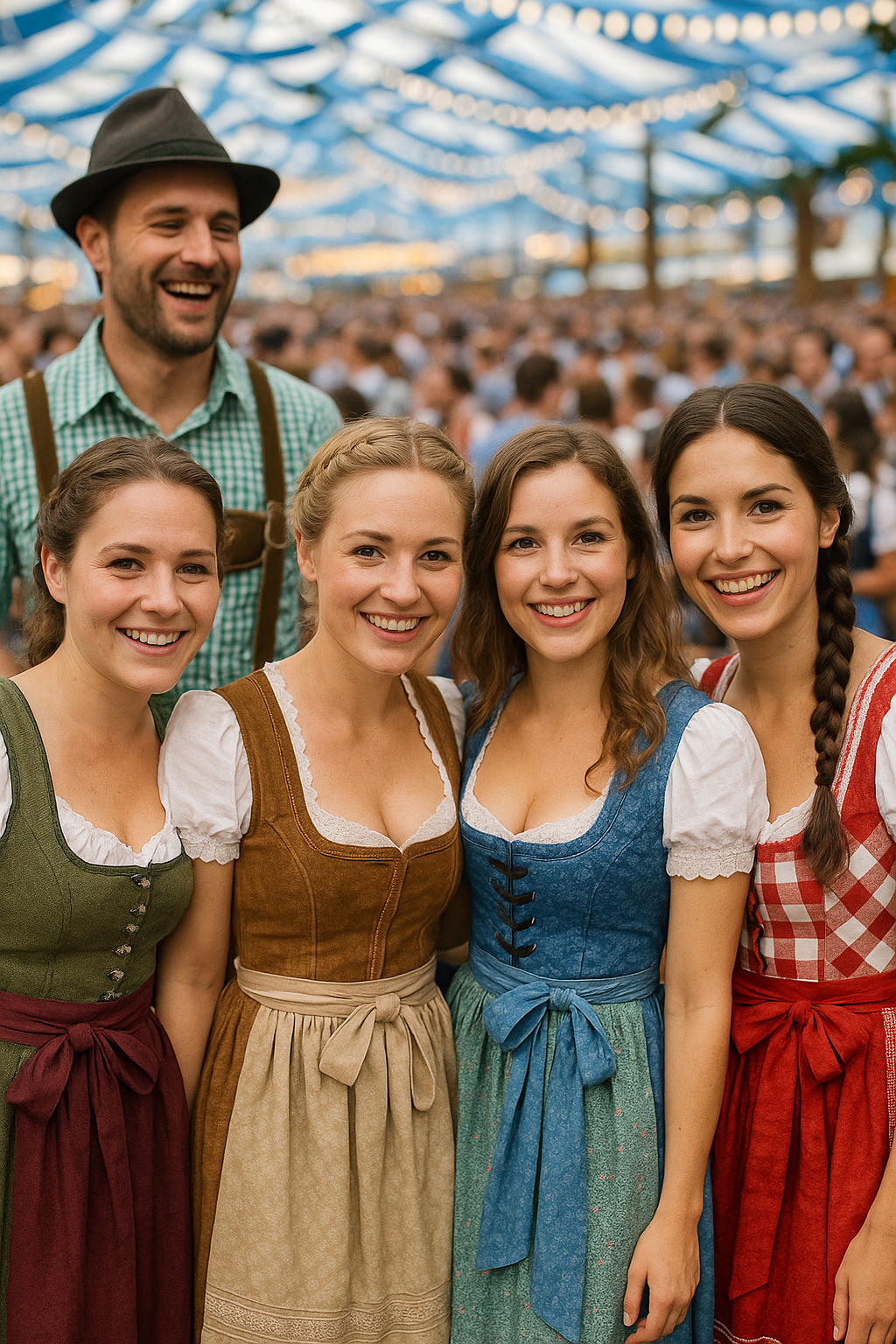One of the most important factors in creating a beautiful dirndl is the fabric choice. The women’s Oktoberfest outfit comes in silk, velvet, cotton, or net material to suit different casual to festive occasions. The fabric affects not only the appearance and durability of the dirndl but also its comfort and suitability for different occasions.
Dirndl consists of a bodice, blouse, and skirt, often with an apron; each component is crafted with intricate detailing and premium fabrication. Dirndl evolved when Royal introduced luxurious fabric in simple workwear, and from that time, multiple fashion adaptations have been made in outfit production. Today, to cater to each individual's preference, different fabrics, from breathable cotton to shiny brocade with graphical patterns, are used to make an authentic yet stylish dirndl.
The Basics: Traditional Dirndl Fabrics
Each fabric has unique properties and benefits for women, whether for a casual summer gathering or a formal winter event.
Cotton: Versatile and Comfortable Dirndls
Cotton is the most traditional and widely used for dirndl manufacturing due to its breathability, durability, and ability to hold prints well. Cotton fibers are derived from the Gossypium plant and are primarily composed of 98% cellulose. Its tenacity of 3-5 grams makes it moderately strong, prevents fibers from breaking, and makes your dirndl long-lasting. The skirt fabric is often printed cotton with traditional Bavarian or Austrian patterns, while the bodice may be made from a solid color like white cotton.
Benefits:
-
Cotton can easily dyed and printed, allowing for a variety of patterns and styles in Dirndl designs.
-
Made of 100% cotton or a cotton-polyester blend, dirndls are medium weight, offer a perfect drape that skims the body, and resist wrinkling.
-
Due to its soft fiber texture, it is ideal for sensitive skin and provides comfortable dirndl wear throughout the day.
-
Cotton dirndls are versatile and easy to carry, which makes them suitable for various casual and occasional wear.
-
Its resilience to stretch also maintains a dirndl shape well, offering a flattering fit.
Linen Dirndls: Cool and Rustic Charm
Liner dirndls are perfect for summer festivals and outdoor events due to their moisture-wicking properties. They help regulate body temperature and are highly breathable, keeping the wearer cool in warmer weather. Linen is a natural fabric that has been used to produce dirndls for centuries. In the past, dirndls worn for everyday use were made from sturdy, colored linen, sometimes with a leather bodice and trim. The aprons, which are an important part of dirndl, were made from bed linen in those days with floral and vine patterns.
As fashion evolved, premium linen types like soft and durable Belgian linen, smooth and silky Flemish linen, and linen weaves are favored for high-end dirndls. The natural texture of linen complements the intricate pattern and embroidery found in luxurious dirndl fabrics like Damask linen.
Benefits:
-
Linen’s natural, rustic appearance also adds an authentic touch to traditional dirndl design.
-
The fabric offers a light and airy feel, making the dirndl a lightweight and timeless appeal in warmer atmospheres.
-
Linen dirndls become softer after washing and provide comfort against the skin.
-
Embroidered linen adds decorative elements to blouses and accents on the dirndl.
-
Medium-weight linen offers more structure and support, provides a balanced drape, is suitable for most dirndl styles, and ensures flattering silhouettes.
Velvet: Luxurious Elegance to Traditional Outfit
Rich, velvety fabric is often used to add luxury and elegant appeal to dirndl bodices and skirts. Velvel is a woven fabric characterized by its soft, dense pile. It was traditionally made from silk but is now often crafted from cotton, polyester, or blends. Its unique texture results from a weaving technique that creates cut loops, giving dirndl a rich, shiny appearance that changes color when stroked.
Many famous designers incorporate velvet in making dirndls adorned with intricate embroidery and embellishments, enchanting their festive appeal. The use of velvet in dirndls not only elevates the aesthetic but also provides warmth, especially for Oktoberfest held in the fall season.
Benefits:
-
The rich texture and velvet sheen add a touch of opulence and sophistication to your traditional dirndl design.
-
Durable and highly resilient to wear and tear, Velvet helps dirndl maintain its shape and appearance over time.
-
Many velvet dirndls feature a fitted bodice, accentuating the wearer’s curves, while full skirts and aprons with floral patterns crafted on velvet fabric elevate styling.
Silk: High-End Dirndl Fashion
Silk fibers are exceptionally smooth and straight, giving the fabric a luxurious sheen and soft texture that is highly desirable for high-end dirndl fashion. Despite its delicate appearance, silk is one of the strongest natural fibers, with high tensile strength, which allows garments to maintain their shape and structure with 10% to 20% stretch.
Multiple silk types, satin, charmeuse, dupioni, and chiffon, are used for more exclusive and designer dirndls; a bodice made with silk organza elevates the shimmery appearance.
Benefits:
-
Silk’s natural sheen creates a beautiful, eye-catching look, especially when paired with traditional dirndl patterns and embroidery.
-
Silk can be styled in various ways, allowing for creative designs and embellishments in dirndl fashion.
-
Dirndl, made from silk, is lightweight in nature and offers good air circulation, perfect for every weather condition.
-
Silk fabric can be woven into a variety of textures and finishes, from satin to crepe, setting it apart from other options and giving dirndl a premium feel.
-
The smooth, soft feel of silk adds an elegant, high-quality look to dirndl, which is ideal for formal occasions. Apron and skirt made of silk add extra flair to the stunning dirndl appeal.
Brocade: Elevate Dirndl Aesthetics
Brocade is a richly decorative, shuttle-woven fabric often made with colored silks and sometimes gold and silver threads. It features intricate, raised patterns that appear embroidered but are actually woven into the fabric, elevating the lustrous sheen of the dirndl outfit.
Many brocade dirndls are made from polyester, with a combination of materials like polyamide and elastane for comfort and fit.
To maintain authenticity, traditional brocade dirndls commonly feature floral motifs, geometric designs, and intricate paisley styles.
Benefits:
-
Brocade or jacquard fabric made with metallic or golden-hued thread enhances the dirndl's aesthetic appeal, making it a timeless choice for wedding dirndls or festive events.
-
Brocade dirndls adorned with a diamond neckline, ruffles, and decorative lacing, including matching aprons, add a unique yet stylish visual appeal to your Oktoberfest look.
Other Trending Dirndl Fabrics: Modern and Eco-friendly Choices
Eco-friendly fabrics like organic cotton and Tencel are gaining popularity, reflecting a growing trend toward sustainability in dirndl fashion. Sheer fabrics and translucent materials are being integrated into dirndl attire for playful layering and a hint of skin.
Denim is emerging as a trendy fabric choice for modern dirndls, reflecting a shift towards casual, stylish options. Denim dirndls provide a relaxed, everyday look while maintaining the classic silhouette of traditional attire. Moreover, leather accents and sequins are used to sparkle the authentic design.
Fabric Used to Make Dirndl Components
Some additional complementary accessories, such as blouses, inner linings, or undies, are directly in touch with the body; their fabrication material is important for the wearer's ease of movement.
Inner Blouse Lining Fabric: Breathable Cotton
The inner lining of the dirndl blouse, made from 100% breathable cotton, ensures a soft, comfortable base against the skin and a pleasant wearing experience. The cotton lining complements the outer fabric, and some incorporate elastic bands for a secure, adjustable fit. The high-quality cotton lining is durable and long-lasting, offering the wearer proper blouse shape and comfort.
Petticoat: Soft Cotton, Polyester, or Tulle
A petticoat is an undergarment designed to be worn beneath a dirndl or skirt to enhance its shape and volume. Traditionally, it is made from soft fabrics like cotton, polyester, or tulle. This helps the outer skirt swing gracefully by adding volume and giving it a frothy appearance. While not always necessary, petticoats under the dirndl skirts have become popular again for their elegance and comfort in traditional bavarian attire.
Blouse Fabric Material: Lightweight Cotton or Silk
The blouse complements the bodice and is designed to enhance the decollete. It is typically made from lightweight fabrics like cotton or silk to provide a smooth feel against the skin.
At Lederhosen Store, we offer classic pure cotton dirndl blouses with lace trims and puffed sleeves that are comfortable and pair well with your dirndl dress.
Apron: Lustrous or Premium Quality Fabric
The apron is a key element and can be customized with various fabrics, colors, and designs. Popular choices include silk satin, lace, cotton satin, and even velvet for the vintage look. The apron adds a decorative layer and can be tied to indicate the wearer's marital status.
It is the most exposed part of the dress, so manufacturers prioritize quality fabric choices with delicate printing, color patterns, and crafted pleats and frills to add an eye-catching effect to the outfit.
Seasonal Trends Influence Fabric Choice for Dirndl Making:
You can't wear every fabric dirndl option in every season. Fabric selection is significantly impacted by climate and fashion preferences.
Spring/ Summer Trends:
Fabrics like cotton and linen-made dirndls are favored in warmer months for their breathability and cooling properties. Floral designs and vibrant colors dominate, reflecting the season’s freshness. Designers often incorporate sheer fabrics and pastel shades to elevate the feminine aesthetic of dirndls for events like Oktoberfest.
Fall/ Winter Trends:
As temperatures drop, heavier fabrics such as wool, velvet, and brocade become popular. These materials provide warmth and structure, with darker colors and rich textures reflecting the season’s mood. Long sleeves, dirndl blouses, and lace details are also in demand, catering to both style and ease during colder months.
Final Words
Dirndl fabrication is essential in defining the dress’s appearance, softness, stretching ability, and suitability for various occasions. From the everyday practicality of cotton and linen to the luxurious elegance of silk and velvet, each fabric brings its unique set of characteristics to the table. Understand the properties of each material that complement the production of dirndl components well. Our dirndls ensure that the final product is not only beautiful but also comfortable and durable for our customers.

